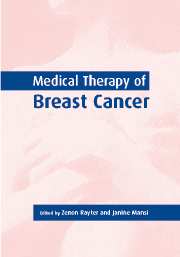Book contents
- Frontmatter
- Contents
- List of contributors
- 1 History of breast cancer therapy
- 2 Chemoprevention of breast cancer
- 3 Familial breast cancer
- 4 Hormone replacement therapy and breast cancer
- 5 Screening for breast cancer
- 6 The management of in situ breast cancer
- 7 Adjuvant systemic therapy
- 8 Adjuvant radiotherapy in the management of breast cancer
- 9 Predictors of response and resistance to medical therapy
- 10 Primary medical therapy in breast cancer
- 11 Medical therapy of advanced disease
- 12 Experimental approaches
- 13 The place of bisphosphonates in the management of breast cancer
- 14 Palliative care in breast cancer
- Index
4 - Hormone replacement therapy and breast cancer
Published online by Cambridge University Press: 06 January 2010
- Frontmatter
- Contents
- List of contributors
- 1 History of breast cancer therapy
- 2 Chemoprevention of breast cancer
- 3 Familial breast cancer
- 4 Hormone replacement therapy and breast cancer
- 5 Screening for breast cancer
- 6 The management of in situ breast cancer
- 7 Adjuvant systemic therapy
- 8 Adjuvant radiotherapy in the management of breast cancer
- 9 Predictors of response and resistance to medical therapy
- 10 Primary medical therapy in breast cancer
- 11 Medical therapy of advanced disease
- 12 Experimental approaches
- 13 The place of bisphosphonates in the management of breast cancer
- 14 Palliative care in breast cancer
- Index
Summary
Introduction
The cessation of menstruation is termed the menopause, the median age of which is 51 years in the United Kingdom, whereas the climacteric (or perimenopause) is the transitional period leading up to this during which ovarian function ceases and symptoms of ovarian failure may become manifest. This usually predates the menopause by approximately two to three years in the majority of women. Ovarian failure arises as a result of a reduction in ovarian responsiveness to gonadotrophin stimulation combined with an exhaustion of viable oocytes. As oestradiol production is predominantly dependent on oocyte maturation with an increase in anovulatory cycles, serum levels subsequently fall, endometrial stimulation fails to occur and amenorrhoea results. The short and long-term sequelae of this decline in ovarian oestrogen production are summarized in Table 4.1.
Vasomotor symptoms and their psychological sequelae can severely impair a women's quality of life (Daly et al., 1993). Symptoms are experienced by 75% of climacteric and early postmenopausal women but are usually self-limiting, lasting two to three years, although they can be life-long in a minority of women (Belchetz, 1994). Vaginal dryness and the subsequent superficial dyspareunia experienced by a proportion of women may contribute to loss of libido. Coronary artery disease is the most common cause of morbidity and mortality in women in many countries including the United Kingdom (Office for National Statistics Population and Health Monitor, 1997) and is the most frequent non-neoplastic cause of death in node-negative breast cancer survivors (Rosen et al., 1993).
- Type
- Chapter
- Information
- Medical Therapy of Breast Cancer , pp. 72 - 102Publisher: Cambridge University PressPrint publication year: 2003

